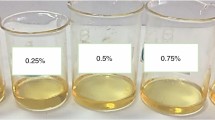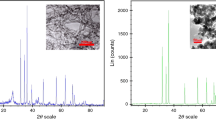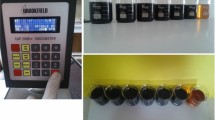Abstract
Nowadays, various types of engine oils are widely used in lubricating and cooling internal combustion engines. In this study, the behavior of MWCNTs–SiO2 (30–70)/10W40 hybrid nanofluid as part of a new generation of engine oil is investigated experimentally. A mixture of SiO2, with 20–30 nm particle diameter, and MWCNT, with 3–5 nm inner and 5–15 nm outer nanoparticle diameter was dispersed into a base fluid of 10W40 engine oil. Then, the viscosity of the product was measured at nanofluid concentrations and temperatures, respectively, ranging from 0.05 to 1% and 5 to 55 °C, for different values of shear rate. Also, a sensitivity analysis to the solid volume fraction was performed at different temperatures. The results show that the behavior of the samples is well fitted with the pseudo-plastic Ostwald de Waele non-Newtonian model. The viscosity of the produced hybrid nano-lubricant is found to be 35% greater than that of pure engine oil. Because of the significant deviation between the measured viscosity and the values predicted by existing classical viscosity models, a new regression model is obtained. The R2 and adj. R2 for the model are computed as 0.988 and 0.977, respectively, signifying strong predictability with ± 3% margin of deviation.













Similar content being viewed by others
Abbreviations
- a :
-
The distance between any two nanoparticles (m)
- h :
-
Nanoparticle diameter (m)
- K :
-
Structure-dependent parameters
- m :
-
Consistency index
- n :
-
Power-law index
- t :
-
Structure-dependent parameter
- T :
-
Temperature (°C)
- w :
-
Mass (g)
- \(\dot{\gamma }\) :
-
Shear rate (s−1)
- µ :
-
Dynamic viscosity (poise)
- ρ :
-
Density (kg m−3)
- τ :
-
Shear stress (dyne cm−2)
- φ :
-
Nanoparticles volume fraction
- bf:
-
Base fluid
- nf:
-
Nanofluid
- HB:
-
Herschel–Bulkley
- OW:
-
Ostwald de Waele
- Y:
-
Yield stress
References
Murshed SMS, Leong KC, Yang C. Thermophysical and electrokinetic properties of nanofluids—a critical review. Appl Therm Eng. 2008;28:2109–25. https://doi.org/10.1016/j.applthermaleng.2008.01.005.
Boungiorno J, Hu L, Kim S, Hannink R, Truong B, Forrest E. Nanofluids for enhanced economics and safety of nuclear reactors: an evaluation of the potential features issues, and research gaps. Nucl Technol. 2008;162:80–91.
Saidur R, Leong KY, Mohammad HA. A review on applications and challenges of nanofluids. Renew Sustain Energy Rev. 2011;15:1646–68. https://doi.org/10.1016/j.rser.2010.11.035.
Murshed SMS, de Castro CAN. Nanofluids as advanced coolants. In: Mohammad A, editor. Green solvents I prop. appl. chem. Dordrecht: Springer; 2012. p. 397–415. https://doi.org/10.1007/978-94-007-1712-1_14.
Sidik NAC, Mohammed HA, Alawi OA, Samion S. A review on preparation methods and challenges of nanofluids. Int Commun Heat Mass Transf. 2014;54:115–25. https://doi.org/10.1016/j.icheatmasstransfer.2014.03.002.
Yu WH, France DM, Routbort JL, Choi SUS. Review and comparison of nanofluid thermal conductivity and heat transfer enhancements. Heat Transf Eng. 2008;29:432–60. https://doi.org/10.1080/01457630701850851.
Sarkar J. A critical review on convective heat transfer correlations of nanofluids. Renew Sustain Energy Rev. 2011;15:3271–7. https://doi.org/10.1016/j.rser.2011.04.025.
Godson L, Raja B, Mohan Lal D, Wongwises S. Enhancement of heat transfer using nanofluids-an overview. Renew Sustain Energy Rev. 2010;14:629–41. https://doi.org/10.1016/j.rser.2009.10.004.
Kleinstreuer C, Feng Y. Experimental and theoretical studies of nanofluid thermal conductivity enhancement: a review. Nanoscale Res Lett. 2011;6:229. https://doi.org/10.1186/1556-276X-6-229.
Murshed SMS, Nieto de Castro CA. Superior thermal features of carbon nanotubes-based nanofluids—a review. Renew Sustain Energy Rev. 2014;37:155–67. https://doi.org/10.1016/j.rser.2014.05.017.
Murshed SMS, Estellé P. A state of the art review on viscosity of nanofluids. Renew Sustain Energy Rev. 2017;76:1134–52. https://doi.org/10.1016/j.rser.2017.03.113.
Prasher R, Song D, Wang J, Phelan P. Measurements of nanofluid viscosity and its implications for thermal applications. Appl Phys Lett. 2006;89:67–70. https://doi.org/10.1063/1.2356113.
Vajjha RS, Das DK. A review and analysis on influence of temperature and concentration of nanofluids on thermophysical properties, heat transfer and pumping power. Int J Heat Mass Transf. 2012;55:4063–78. https://doi.org/10.1016/j.ijheatmasstransfer.2012.03.048.
Sundar LS, Sharma KVV, Naik MTT, Singh MK. Empirical and theoretical correlations on viscosity of nanofluids: a review. Renew Sustain Energy Rev. 2013;25:670–86. https://doi.org/10.1016/j.rser.2013.04.003.
Meyer JP, Adio SA, Sharifpur M, Nwosu PN. The viscosity of nanofluids: a review of the theoretical, empirical, and numerical models. Heat Transf Eng. 2016;37:387–421. https://doi.org/10.1080/01457632.2015.1057447.
Chen H, Ding Y, Tan C. Rheological behaviour of nanofluids. New J Phys. 2007;9:367–367. https://doi.org/10.1088/1367-2630/9/10/367.
Mahbubul IMM, Saidur R, Amalina MAA. Latest developments on the viscosity of nanofluids. Int J Heat Mass Transf. 2012;55:874–85. https://doi.org/10.1016/j.ijheatmasstransfer.2011.10.021.
Mishra PC, Mukherjee S, Nayak SK, Panda A. A brief review on viscosity of nanofluids. Int Nano Lett. 2014;4:109–20. https://doi.org/10.1007/s40089-014-0126-3.
Hemmat Esfe M, Saedodin S, Rejvani M, Shahram J. Experimental investigation, model development and sensitivity analysis of rheological behavior of ZnO/10W40 nano-lubricants for automotive applications. Phys E Low-Dimens Syst Nanostructures. 2017;90:194–203. https://doi.org/10.1016/j.physe.2017.02.015.
Mondragón R, Segarra C, Martínez-cuenca R, Juliá JE, Carlos J. Experimental characterization and modeling of thermophysical properties of nano fluids at high temperature conditions for heat transfer applications. Powder Technol. 2013;249:516–29. https://doi.org/10.1016/j.powtec.2013.08.035.
Hemmat Esfe M, Rostamian H, Rejvani M, Emami MRS. Rheological behavior characteristics of ZrO2–MWCNT/10w40 hybrid nano-lubricant affected by temperature, concentration, and shear rate: an experimental study and a neural network simulating. Phys E Low-Dimens Syst Nanostructures. 2018;102:160–70. https://doi.org/10.1016/j.physe.2017.12.023.
Hemmat Esfe M, Rostamian H, Reza Sarlak M, Rejvani M, Alirezaie A. Rheological behavior characteristics of TiO2–MWCNT/10w40 hybrid nano-oil affected by temperature, concentration and shear rate: an experimental study and a neural network simulating. Phys E Low-Dimens Syst Nanostructures. 2017;94:231–40. https://doi.org/10.1016/j.physe.2017.07.012.
Murshed SM, Santos FJ, de Castro CA. Investigations of viscosity of silicone oil-based semiconductor nanofluids. J Nanofluids. 2013;2:261–6.
Chen L, Xie H. Silicon oil based multiwalled carbon nanotubes nanofluid with optimized thermal conductivity enhancement. Colloids Surf A Physicochem Eng Asp. 2009;352:136–40. https://doi.org/10.1016/j.colsurfa.2009.10.015.
He Y, Jin Y, Chen H, Ding Y, Cang D, Lu H. Heat transfer and flow behaviour of aqueous suspensions of TiO2 nanoparticles (nanofluids) flowing upward through a vertical pipe. Int J Heat Mass Transf. 2007;50:2272–81. https://doi.org/10.1016/j.ijheatmasstransfer.2006.10.024.
Abdollahi-Moghaddam M, Rejvani M, Alamdari P. Determining optimal formulations and operating conditions for Al2O3/water nanofluid flowing through a microchannel heat sink for cooling system purposes using statistical and optimization tools. Therm Sci Eng Prog. 2018;8:517–24. https://doi.org/10.1016/j.tsep.2018.10.009.
Rejvani M, Moghaddam MA, Alamdari P. Using statistical and optimization tools for determining optimal formulations and operating conditions for Al2O3/(EG + Water) nanofluids for cooling system. Therm Sci Eng Prog. 2018;7:230–40. https://doi.org/10.1016/j.tsep.2018.07.003.
Esfe MH, Wongwises S, Rejvani M. Prediction of thermal conductivity of carbon nanotube-EG nanofluid using experimental data by ANN. Curr Nanosci. 2017;13:1–6. https://doi.org/10.2174/1573413713666161213114458.
Lee J-HH, Hwang KS, Jang SP, Lee BH, Kim JH, Choi SUSS, Choi CJ. Effective viscosities and thermal conductivities of aqueous nanofluids containing low volume concentrations of Al2O3 nanoparticles. Int J Heat Mass Transf. 2008;51:2651–6. https://doi.org/10.1016/j.ijheatmasstransfer.2007.10.026.
Yang L, Du K, Bao S, Wu Y. Investigations of selection of nanofluid applied to the ammonia absorption refrigeration system. Int J Refrig. 2012;35:2248–60. https://doi.org/10.1016/j.ijrefrig.2012.08.003.
Hemmat Esfe M, Hassani Ahangar MR, Rejvani M, Toghraie D, Hajmohammad MH. Designing an artificial neural network to predict dynamic viscosity of aqueous nanofluid of TiO2 using experimental data. Int Commun Heat Mass Transf. 2016;75:192–6. https://doi.org/10.1016/j.icheatmasstransfer.2016.04.002.
Sharma AK, Tiwari AK, Dixit AR. Rheological behaviour of nanofluids: a review. Renew Sustain Energy Rev. 2016;53:779–91. https://doi.org/10.1016/j.rser.2015.09.033.
Thomas S, Sobhan CBP. A review of experimental investigations on thermal phenomena in nanofluids. Nanoscale Res Lett. 2011;6:377. https://doi.org/10.1186/1556-276x-6-377.
Einstein A. Eine neue bestimmung der moleküldimensionen. Ann Phys. 1906;324:289–306. https://doi.org/10.1002/andp.19063240204.
Frankel NA, Acrivos A. On the viscosity of a concentrated suspension of solid spheres. Chem Eng Sci. 1967;22:847–53.
Nielsen LE. Generalized equation for the elastic moduli of composite materials. J Appl Phys. 1970;41:4626. https://doi.org/10.1063/1.1658506.
Mooney M. The viscosity of a concentrated suspension of spherical particles. J Colloid Sci. 1951;6:162–70. https://doi.org/10.1016/0095-8522(51)90036-0.
Graham AL. On the viscosity of suspensions of solid spheres. Appl Sci Res. 1981;37:275–86.
De Bruijn H. The viscosity of suspensions of spherical particles. (The fundamental η-c and φ relations). Recl Des Trav Chim Des Pays-Bas. 1942;61:863–74.
Brinkman HC. The viscosity of concentrated suspensions and solutions. J Chem Phys. 1952;20:571.
Batchelor BGK. The effect of Brownian motion on the bulk stress in a suspension of spherical particles. J Fluid Mech. 1977;83:97–117.
Krieger IM, Dougherty TJ, Nielsen LE. A mechanism for non-newtonian flow in suspensions of rigid spheres. Trans Soc Rheol. 1959;3:137–52. https://doi.org/10.1122/1.548848.
Wang X, Xu X, Choi SUS. Thermal conductivity of nanoparticle—fluid mixture. J Thermophys Heat Transf. 1999;13:474–80. https://doi.org/10.2514/2.6486.
Hemmat Esfe M, Saedodin S, Mahian O, Wongwises S. Thermophysical properties, heat transfer and pressure drop of COOH-functionalized multi walled carbon nanotubes/water nanofluids. Int Commun Heat Mass Transf. 2014;58:176–83. https://doi.org/10.1016/j.icheatmasstransfer.2014.08.037.
Hemmat Esfe M, Saedodin S. An experimental investigation and new correlation of viscosity of ZnO–EG nanofluid at various temperatures and different solid volume fractions. Exp Therm Fluid Sci. 2014;55:1–5. https://doi.org/10.1016/j.expthermflusci.2014.02.011.
Hemmat Esfe M, Saedodin S, Mahian O, Wongwises S. Heat transfer characteristics and pressure drop of COOH-functionalized DWCNTs/water nanofluid in turbulent flow at low concentrations. Int J Heat Mass Transf. 2014;73:186–94. https://doi.org/10.1016/j.ijheatmasstransfer.2014.01.069.
Esfe MH, Saedodin S, Asadi A. An empirical investigation on the dynamic viscosity of Mg (OH) 2–ethylene glycol in different solid concentrations and proposing new correlation based on experimental data. Int J Nat Eng Sci. 2014;8:29–34.
Hemmat Esfe M, Saedodin S, Wongwises S, Toghraie D. An experimental study on the effect of diameter on thermal conductivity and dynamic viscosity of Fe/water nanofluids. J Therm Anal Calorim. 2015;119:1817–24. https://doi.org/10.1007/s10973-014-4328-8.
Hemmat Esfe M, Abbasian Arani AA, Rezaie M, Yan WM, Karimipour A. Experimental determination of thermal conductivity and dynamic viscosity of Ag–MgO/water hybrid nanofluid. Int Commun Heat Mass Transf. 2015;66:189–95. https://doi.org/10.1016/j.icheatmasstransfer.2015.06.003.
Estellé P, Halelfadl S, Doner N, Maré T. Shear history effect on the viscosity of carbon nanotubes water-based nanofluid. Curr Nanosci. 2013;9:225–30. https://doi.org/10.2174/1573413711309020010.
Halelfadl S, Estellé P, Aladag B, Doner N, Maré T. Viscosity of carbon nanotubes water-based nanofluids: influence of concentration and temperature. Int J Therm Sci. 2013;71:111–7. https://doi.org/10.1016/j.ijthermalsci.2013.04.013.
Phuoc TX, Massoudi M, Chen R-HH. Viscosity and thermal conductivity of nanofluids containing multi-walled carbon nanotubes stabilized by chitosan. Int J Therm Sci. 2011;50:12–8. https://doi.org/10.1016/j.ijthermalsci.2010.09.008.
Estellé P, Halelfadl S, Maré T. Lignin as dispersant for water-based carbon nanotubes nanofluids: impact on viscosity and thermal conductivity. Int Commun Heat Mass Transf. 2014;57:8–12. https://doi.org/10.1016/j.icheatmasstransfer.2014.07.012.
Hung Y, Chou W. Chitosan for suspension performance and viscosity of MWCNTs. Int J Chem Eng Appl. 2012;3:343–6. https://doi.org/10.7763/IJCEA.2012.V3.215.
Harish S, Ishikawa K, Einarsson E, Aikawa S, Inoue T. Temperature dependent thermal conductivity increase of aqueous nanofluid with single walled carbon nanotube inclusions. Mater Express. 2012;2:213–23.
Sadri R, Ahmadi G, Togun H, Dahari M, Kazi SN, Sadeghinezhad E, Zubir N. An experimental study on thermal conductivity and viscosity of nanofluids containing carbon nanotubes. Nanoscale Res Lett. 2014;9:151–66. https://doi.org/10.1186/1556-276X-9-151.
Richmond WR, Jones RL, Fawell PD. The relationship between particle aggregation and rheology in mixed silica–titania suspensions. Chem Eng J. 1998;71:67–75. https://doi.org/10.1016/S1385-8947(98)00105-3.
Mondragon R, Enrique Julia J, Barba A, Jarque JC. Determination of the packing fraction of silica nanoparticles from the rheological and viscoelastic measurements of nanofluids. Chem Eng Sci. 2012;80:119–27. https://doi.org/10.1016/j.ces.2012.06.009.
Chevalier J, Tillement O, Ayela F. Structure and rheology of SiO2 nanoparticle suspensions under very high shear rates. Phys Rev E Stat Nonlinear Soft Matter Phys. 2009;80:1–7. https://doi.org/10.1103/physreve.80.051403.
Farbod M, Ahangarpour A. Improved thermal conductivity of Ag decorated carbon nanotubes water based nanofluids. Phys Lett A. 2016;380:4044–8. https://doi.org/10.1016/j.physleta.2016.10.014.
Esfe MH, Rejvani M, Karimpour R, Abbasian Arani AAAA. Estimation of thermal conductivity of ethylene glycol-based nanofluid with hybrid suspensions of SWCNT–Al2O3 nanoparticles by correlation and ANN methods using experimental data. J Therm Anal Calorim. 2017;128:1–13. https://doi.org/10.1007/s10973-016-6002-9.
Chen H, Ding Y. Heat transfer and rheological behaviour of nanofluids – a review. In: Wang L, editor. Advances in transport phenomena, vol 1. Berlin: Springer; 2009. p. 135–77.
Hemmat Esfe M, Esfandeh S, Rejvani M. Modeling of thermal conductivity of MWCNT–SiO2 (30:70%)/EG hybrid nanofluid, sensitivity analyzing and cost performance for industrial applications: an experimental based study. J Therm Anal Calorim. 2018;131:1437–47. https://doi.org/10.1007/s10973-017-6680-y.
Hemmat Esfe M, Abbasian Arani AA, Shafiei Badi R, Rejvani M. ANN modeling, cost performance and sensitivity analyzing of thermal conductivity of DWCNT–SiO2/EG hybrid nanofluid for higher heat transfer: an experimental study. J Therm Anal Calorim. 2018;131:2381–93. https://doi.org/10.1007/s10973-017-6744-z.
Anoop K, Sadr R, Al-Jubouri M, Amani M. Rheology of mineral oil-SiO2 nanofluids at high pressure and high temperatures. Int J Therm Sci. 2014;77:108–15. https://doi.org/10.1016/j.ijthermalsci.2013.10.016.
Baghbanzadeh M, Rashidi A, Soleimanisalim AH, Rashtchian D. Investigating the rheological properties of nanofluids of water/hybrid nanostructure of spherical silica/MWCNT. Thermochim Acta. 2014;578:53–8. https://doi.org/10.1016/j.tca.2014.01.004.
Hemmat Esfe M, Karimpour R, Abbasian Arani AA, Shahram J. Experimental investigation on non-Newtonian behavior of Al2O3-MWCNT/5W50 hybrid nano-lubricant affected by alterations of temperature, concentration and shear rate for engine applications. Int Commun Heat Mass Transf. 2017;82:97–102. https://doi.org/10.1016/j.icheatmasstransfer.2017.02.006.
Esfe MH, Esfandeh S, Afrand M, Rejvani M, Rostamian SH. Experimental evaluation, new correlation proposing and ANN modeling of thermal properties of EG based hybrid nanofluid containing ZnO–DWCNT nanoparticles for internal combustion engines applications. Appl Therm Eng. 2018;133:452–63. https://doi.org/10.1016/j.applthermaleng.2017.11.131.
Hemmat Esfe M, Alirezaie A, Rejvani M. An applicable study on the thermal conductivity of SWCNT–MgO hybrid nanofluid and price-performance analysis for energy management. Appl Therm Eng. 2017;111:1202–10. https://doi.org/10.1016/j.applthermaleng.2016.09.091.
Daungthongsuk W, Wongwises S. A critical review of convective heat transfer of nanofluids. Renew Sustain Energy Rev. 2007;11:797–817. https://doi.org/10.1016/j.rser.2005.06.005.
Chang TB, Syu SC, Yang YK. Effects of particle volume fraction on spray heat transfer performance of Al2O3-water nanofluid. Int J Heat Mass Transf. 2012;55:1014–21. https://doi.org/10.1016/j.ijheatmasstransfer.2011.10.009.
Herschel WH, Bulkley R. Konsistenzmessungen von Gummi-Benzoll-sungen. Kolloid-Zeitschrift. 1926;39:291–300. https://doi.org/10.1007/BF01432034.
Pordanjani AH, Vahedi SM, Rikhtegar F, Wongwises S. Optimization and sensitivity analysis of magneto-hydrodynamic natural convection nanofluid flow inside a square enclosure using response surface methodology. J Therm Anal Calorim. 2018. https://doi.org/10.1007/s10973-018-7652-6.
Author information
Authors and Affiliations
Corresponding author
Additional information
Publisher's Note
Springer Nature remains neutral with regard to jurisdictional claims in published maps and institutional affiliations.
Rights and permissions
About this article
Cite this article
Rejvani, M., Saedodin, S., Vahedi, S.M. et al. Experimental investigation of hybrid nano-lubricant for rheological and thermal engineering applications. J Therm Anal Calorim 138, 1823–1839 (2019). https://doi.org/10.1007/s10973-019-08225-5
Received:
Accepted:
Published:
Issue Date:
DOI: https://doi.org/10.1007/s10973-019-08225-5




